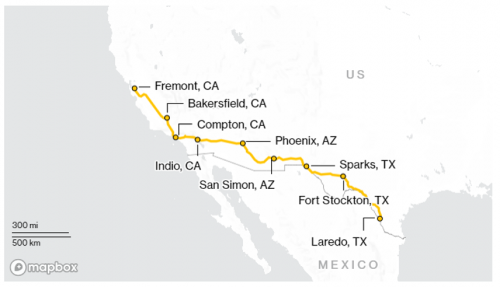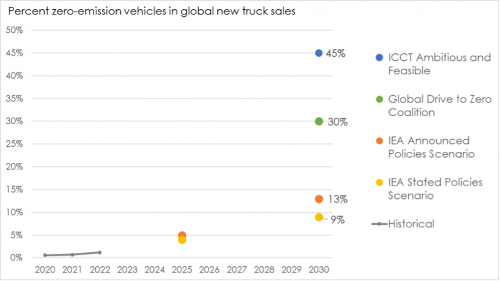This piece was authored by Muhammad Abdullah, an 2023 summer Transportation Policy intern with Energy Innovation and Energy Innovation’s Chris Busch, Director Transportation and Senior Economist.
Ella Kissi-Debrah was born, raised, and died a tragically early death in south London, a hot spot for motor vehicle pollution. Ella’s autopsy found that at even at nine years old, her death was triggered by chronic exposure to the nitrogen dioxide and particulate matter from motor vehicle exhaust.[1] Per the coroner’s report, “Ella died of asthma contributed to by exposure to excessive air pollution.” [2]
Vehicle pollution contributing to an untimely death is all too common of a story. Commercial freight vehicles cause much of this damage because of their diesel engines, which are well-suited for hauling commercial loads but also create more hazardous pollution.
Diesel exhaust contains 40 cancer-causing substances as well as high levels of particulate matter, or fine soot.[3] As a result, diesel truck emissions are particularly harmful to human health, contributing to respiratory disease, hospitalization, cancer, and even premature deaths like Ella’s.[4] Motor vehicle exhaust causes an estimated four million new asthma cases in kids each year, or 11,000 per day, according to the World Health Organization.[5] Globally, transportation – cars, trucks, planes, trains, and ships – are responsible for around 360,00 deaths each year, where diesel-fueled vehicles are responsible for almost half (47 percent) of this premature death toll.[6]
Fortunately, technological advances mean cleaner alternatives are increasingly available. But further policy action is needed to speed their adoption.
MORE AMBITIOUS POLICY TO CAPITALIZE ON GROWING MOMENTUM
The International Energy Agency’s climate roadmap concludes zero-emission vehicle (ZEV) trucks have the fifth largest potential for greenhouse gas reductions of any technology, across all economic sectors.[7] Today, freight carrying ZEVs are on the rise, owing to growing technological maturity and steady market gains.[8] Globally, ZEV truck sales doubled in 2022, reaching 1.2 percent of sales,[9] and are expected to double again in 2023.[10] Meanwhile, from 2021 to 2023, the number of ZEV trucks available on the market jumped from 200 to 350 models.[11] Such trends make a rapid transition to zero-emission trucks possible, but depend on policymakers creating stronger measures to support ZEV truck adoption.
Divergence of Zero-Emission Truck Sales with Current vs. Recommended Policy
Current trends show ZEV truck sales falling short of the levels needed to fully realize their potential. Today, ZEVs are forecasted to grow to 9 to 13 percent of truck sales in 2030 as shown above. To reach our climate goals, global ZEV trucks sales should reach at least 30 percent, according to the International Energy Agency’s Net Zero Energy roadmap.[15] A 30 percent ZEV truck sales target has also been adopted by the Commercial Drive to Zero initiative, a coalition including 27 countries as well as major companies and financial institutions.[16]Policymakers should aim for ZEV trucks to grow to at least 45 percent of 2030 sales, according to the respected International Council on Clean Transportation (ICCT).[17] ICCT recommended this level to members of the ZEV Transition Council commits members to an accelerated ZEV transition and includes nations representing more than half of global new vehicles sales.[18] The 45 percent ZEV truck sales target is recommended due to expected widespread “commercial availability” as well as “cost of ownership projections,” pointing to electric trucks being cheaper in the 2030s.[19]
CALIFORNIA AT THE FOREFRONT ON ZERO EMISSION TRUCK POLICY
California has been at the forefront on zero-emission truck policies over the past two years, spurred by growing opportunities for scaling ZEV trucks up and diesel’s continued public health toll. Though California has been a leader in clean transportation for decades, diesel exhaust is estimated to be responsible for 70 percent of the cancer risk for the state’s residents attributable to toxic air contaminants, causing around 1,400 premature deaths each year.[20]
California’s ZEV truck policy is state-of-the-art with the recent Advanced Clean Fleet policy, adopted in April of this year.[21] This policy sets a 2036 timeline for a 100 percent transition to zero emission technology in new truck sales.[22] Another Advanced Clean Fleets policy innovation is that it phases in increasing ZEV purchase requirement for commercial vehicle fleets, providing the demand-side of the ZEV transition while freeing up scare public revenue for other investments.[23]
WHAT NEXT
New vehicle sales standards are vital for an effective policy strategy. Considering the magnitude of the stakes and the opportunity, other major markets for new trucks need to increase their 2030 ambition, ideally targeting 45 percent ZEV truck sales in that year. Proposed policy in Europe would reach this level, requiring greenhouse gas reductions of 45 percent in 2030 and increasing to 90 percent in 2040.[24] The recent U.S. Environmental Protection Agency proposal is not quite as ambitious and is expected to lead to 2032 new trucks sales of 43 percent ZEVs.[25] Of the largest markets China’s adoption of heavy trucks has been fastest, but China has not set out quantitative targets for ZEV trucks so far.[26]
New vehicle sales standards on their own are insufficient and must be supported by a comprehensive portfolio of policies. We suggest a portfolio that includes consumer incentives, industry standards development, charging infrastructure adequacy, economic development, and equity considerations, such as ensuring smaller trucking operations can access ZEV technology.[27]
Development of a West Coast electric trucking corridor along the I-5 interstate from San Diego to British Columbia began in 2020. Recently, Tesla proposed a high speed truck charging corridor connecting the south Texas border (Laredo) with northern California (Freemont in the Bay Area) leveraging inflation reduction act incentives.
Inflation Reduction Act Spurs Plans for a Zero-Emission Trucking Corridor

Source: Bloomberg [28]
Featured research:
[1] Sandra Laville, “Air Pollution a Cause in Girl’s Death, Coroner Rules in Landmark Case,” The Guardian, December 16, 2020, sec. UK news, https://www.theguardian.com/environment/2020/dec/16/girls-death-contributed-to-by-air-pollution-coroner-rules-in-landmark-case.
[2] Laville.
[3] Research Division, “Diesel Particulate Matter Health Impacts Summary,” California Air Resource Board, n.d., https://ww2.arb.ca.gov/resources/summary-diesel-particulate-matter-health-impacts.
[4] Research Division.
[5] Pattanun Achakulwisut et al., “Global, National, and Urban Burdens of Pediatric Asthma Incidence Attributable to Ambient NO2 Pollution: Estimates from Global Datasets,” The Lancet Planetary Health 3, no. 4 (April 1, 2019): e166–78, https://doi.org/10.1016/S2542-5196(19)30046-4.
[6] Susan Anenberg et al., “A Global Snapshot of the Air Pollution-Related Health Impacts of Transportation Sector Emissions in 2010 and 2015” (International Council on Clean Transportation, 2019), https://theicct.org/wp-content/uploads/2021/06/Global_health_impacts_transport_emissions_2010-2015_20190226.pdf.
[7] International Energy Agency, “Net Zero by 2050” (Paris: IEA, 2021), https://www.iea.org/reports/net-zero-by-2050.
[8] Global Commercial Vehicle Drive to Zero, “Zero-Emission Technology Inventory (ZETI) Data Explorer,” February 24, 2023, https://globaldrivetozero.org/tools/zeti-data-explorer/.
[9] International Energy Agency, “Global EV Outlook 2023” (Paris), accessed August 4, 2023, https://www.iea.org/reports/global-ev-outlook-2023.
[10] Colin McKerracher, “China’s Electric Trucks May Well Pull Forward Peak Oil Demand,” Bloomberg.Com, October 11, 2022, https://www.bloomberg.com/news/articles/2022-10-11/china-s-electric-trucks-may-well-pull-forward-peak-oil-demand.
[11] Global Commercial Vehicle Drive to Zero, “Zero-Emission Technology Inventory (ZETI) Data Explorer.”
[12] Arijit Sen and Josh Miller, “Emissions Reduction Benefits of a Faster, Global Transition to Zero-Emission Vehicles,” Working Paper 15-2022 (International Council on Clean Transportation, March 2022), https://theicct.org/wp-content/uploads/2022/03/Accelerated-ZEV-transition-wp-final.pdf.
[13] Commercial Drive to Zero, “Memorandum of Understanding on Zero-Emission Medium- and Heavy-Duty Vehicles,” December 20, 2021, https://globaldrivetozero.org/site/wp-content/uploads/2021/12/Global-MOU-ZE-MHDVs-signed-20-Dec-21.pdf.
[14] International Energy Agency, “Global EV Data Explorer,” May 23, 2022, https://www.iea.org/data-and-statistics/data-tools/global-ev-data-explorer.
[15] International Energy Agency, “Net Zero by 2050.”
[16] Commercial Drive to Zero, “Memorandum of Understanding on Zero-Emission Commercial Vehicles.”
[17] Sen and Miller, “Emissions Reduction Benefits of a Faster Transition to ZEVs.”
[18] “ZEV Transition Council,” International Council on Clean Transportation (blog), 2022, https://theicct.org/initiatives-partnerships/zev-tc/.
[19] Yihao Xie, Tim Dallmann, and Rachel Muncrief, “Heavy-Duty Zero-Emission Vehicles: Pace and Opportunities for a Rapid Global Transition,” ZEV Transition Council Briefing Paper (International Council on Clean Transportation, May 2022), https://theicct.org/wp-content/uploads/2022/05/globalhvsZEV-hdzev-pace-transition-may22.pdf.
[20] Research Division, “Diesel Particulate Matter Health Impacts Summary.”
[21] California Air Resource Board, “Proposed Advanced Clean Fleets Regulation Preliminary Language Revisions Workshop – Staff Presentation” (Sacramento, CA, February 13, 2023), https://ww2.arb.ca.gov/sites/default/files/2023-02/acfpres230213_ADA.pdf.
[22] California Air Resource Board, “Appendix A4. 2036 100 Percent Medium- and Heavy-Duty Zero-Emission Vehicle Sales Requirements, Preliminary Draft Regulation Order Advanced Clean Fleets Regulation” (Sacramento, CA, February 13, 2023), https://ww2.arb.ca.gov/sites/default/files/2023-02/230213prelim100sales.docx.
[23] California Air Resource Board, “Proposed Advanced Clean Fleets Regulation.”
[24] International Council on Clean Transportation, “Europe Proposes World-Leading Decarbonization Targets for Trucks and Buses,” International Council on Clean Transportation (blog), February 14, 2023, https://theicct.org/pr-europe-co2-standards-trucks-feb-23/.
[25] Coral Davenport, “E.P.A. Lays Out Rules to Turbocharge Sales of Electric Cars and Trucks,” The New York Times, April 12, 2023, sec. Climate, https://www.nytimes.com/2023/04/12/climate/biden-electric-cars-epa.html.
[26] Lingzhi Jin et al., “Opportunities and Pathways to Decarbonize China’s Transportation Sector during the Fourteenth Five-Year Plan Period and Beyond” (International Council on Clean Transportation, November 2021), https://theicct.org/wp-content/uploads/2021/12/China-14th-FYP-Report-v8-nov21.pdf.
[27] Chris Busch and Anand Gopal, “Electric Vehicles Will Soon Lead Global Auto Markets, But Too Slow To Hit Climate Goals Without New Policy” (Energy Innovation: Policy and Technology, LLC, November 3, 2022), https://energyinnovation.org/publication/electric-vehicles-will-soon-lead-global-auto-markets-but-too-slow-to-hit-climate-goals-without-new-policy/.
[28] “Tesla Wants to Build a Semi Truck-Charging Route from Texas to California,” Bloomberg.Com, August 1, 2023, https://www.bloomberg.com/news/articles/2023-08-01/tesla-semi-truck-charging-route-pitched-at-100-million.

